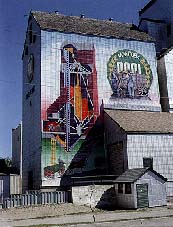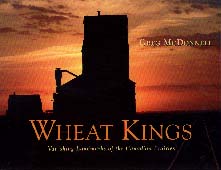|
________________
CM . . . .
Volume V Number 17 . . . . April 23, 1999
excerpt: It's the consummate prairie experience: stepping into an aging country elevator and savouring the rich aroma of new wheat and old wood; listening to the chirping birds while trading stories with the manager; watching battered old grain trucks arrive and talking bushels-per-acre, moisture content, dockage, and the politics of farming with the drivers. It's marveling at the maze of garner levers, slides and scales, legs, cups, boots and belts - and choking back the dust as the manager puts them all into motion to move the latest load of grain from the receiving pit to storage bins.  The prairie experience of using grain elevators in Saskatchewan and
Manitoba is indeed satisfying in this richly illustrated and nostalgically
written book by Greg McDonnell. The book is organized into seven essays,
each chapter illustrated with photographs that bring the prairie alive.
Pictures of the grain elevators, with dramatic sky tones in the
background, seem to show us skeletons of our past. Many of us who are not
familiar with the grain elevator's place in prairie history will benefit
from the information given by 84-year-old farmer Leonard Richmond, as he
leads us through Neelby B, one of the last traditional wooden country
grain elevators still in existence.
The prairie experience of using grain elevators in Saskatchewan and
Manitoba is indeed satisfying in this richly illustrated and nostalgically
written book by Greg McDonnell. The book is organized into seven essays,
each chapter illustrated with photographs that bring the prairie alive.
Pictures of the grain elevators, with dramatic sky tones in the
background, seem to show us skeletons of our past. Many of us who are not
familiar with the grain elevator's place in prairie history will benefit
from the information given by 84-year-old farmer Leonard Richmond, as he
leads us through Neelby B, one of the last traditional wooden country
grain elevators still in existence.
The book was photographed collectively by six noted photographers and written by McDonnell to give voice to grain elevators and how they operated historically to create the story they tell us today. With all of today's technology and "do-things-faster" attitude, it's comforting to know that the old ways of doing things are, in some cases, just fine the way they are. You not only see building structures of various grain elevators, you see agents measuring out a boxcar-load of wheat at Saskatchewan Wheat Pool, old trains traveling through the bare prairie landscape, the "death" of an old grain elevator in Lwevan, SK, and elevator engine parts. The photographs, which sometimes encompass the whole page and sometimes are set amidst commentary, are always dramatic and telling. Though the pictures can easily be read by elementary students, the essays are better understood by junior and senior high school students. Specific information is given on how the grain elevators were built, operated, and how close they are to being lost. "As each one falls, the prairie becomes a lonelier place." Inglis, Manitoba, is featured as Canada's last row of grain elevators, again proving their strength and viability through history. Highly Recommended. Stephanie Yamniuk, who has taught Grades 1-12, is currently a freelance writer and works at the University of Manitoba, Winnipeg, MB.
To comment on this title or this review, send mail to cm@umanitoba.ca.
Copyright © the Manitoba Library Association.
Reproduction for personal use is permitted only if this copyright notice
is maintained. Any other reproduction is prohibited without
permission.
Published by
TABLE OF CONTENTS FOR THIS ISSUE - APRIL 23,
1999.
AUTHORS |
TITLES |
MEDIA REVIEWS |
PROFILES |
BACK ISSUES |
SEARCH |
CMARCHIVE |
HOME
|

